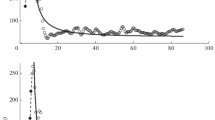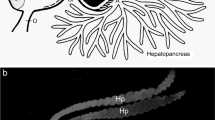Abstract
Changes in the rates of utilization of dissolved compounds during the period of visceral mass regeneration were examined in the crinoid Cenometra bella (Hartlaub). Rates of respiraton and incorporation of labelled amino acids increase, reaching a maximum 2 d after evisceration and returning to normal after 14 d. Rates of incorporation of radioisotope into the organic components of the arms and cirri decrease, while incorporation rate into the visceral mass increases. Incorporation rates of amino acid-derived radioactivity into skeletal carbonate and the ash-free dry weight:protein ratio of arms, cirri and oral disc decrease, reaching a minimum 2 d following evisceration.
Similar content being viewed by others
Literature Cited
Anderson, J. W. and G. C. Stephens: Uptake of organic material by aquatic invertebrates, VI. Role of epiflora in apparent uptake of glycine by marine crustaceans. Mar. Biol. 4, 243–249 (1969)
Barnes, D. J. and C. J. Crossland: Coral calcification: sources of error in radioisotope techniques. Mar. Biol. 42, 119–129 (1977)
De Burgh, M. E., A. B. West and F. Jeal: Adsorption of L-alanine and other dissolved nutients by the spines of Paracentrotus lividus (Echinoidea). J. mar. biol. Ass. U.K. 57, 1031–1045 (1977)
Dendy, A.: On the regeneration of the visceral mass in Antedon rosaceus. Stud. biol. labs Owens Coll. 1, 299–312 (1886)
Hunter-Rowe, C. K. A., F. Jeal and A. B. West: Observations on the feeding behaviour of Thyonv fusus (O. F. Müller). Sci. Proc. R. Dublin Soc. (Ser. A) 5, 459–468 (1978)
Johannes, R. E. and M. Satomi: Measuring organic matter retained by aquatic invertebrates. J. Fish Res. Bd Can. 24, 2467–2471 (1967)
Johannes, R. E. and K. L. Webb: Release of dissolved amino acids by marine zooplankton. Science, N.Y. 150, 76–77 (1965)
Lowry, O. H., N. J. Rosebrough, A. L. Farr and R. J. Randall: Protein measurement with the Folin phenol reagent. J. biol. Chem. 193, 265–275 (1951)
Mayer, D. L.: Feeding behavior and ecology of shallow-water unstalked crinoids (Echinodermata) in the Caribbean Sea. Mar. Biol. 22, 105–129 (1973)
Meyer, D. L.: Length and spacing of the tube feet in crinoids (Echinodermata) and their role in suspension-feeding. Mar. Biol. 51, 361–369 (1979)
Meyer, D. L. and N. G. Lane: The feeding behavior of some Paleozoic crinoids and Recent basketstars. J. Paleont. 50, 472–480 (1976)
Nichols, D.: The histology and activities of the tube feet of Antedon hifida. Q Jl microsc. Sci. 101, 105–117 (1960)
Przibram, H.: Experimentelle Studen über Regeneration. Arch. EntwMech. Org. 11, 321–345 (1901)
Pütter, A.: Die Ernährung der Wassertiere und der Stoffhaushalt der Gewässer, 172 pp. Jena: Fischer 1909
Roth, M.: Fluorescence reaction for amino acids. Analyt. Chem. 43, 880–882 (1971)
Rutman, J. and L. Fishelson: Food composition and feeding behavior of shallow-water crinoids at Eilat (Red Sea). Mar. Biol. 3, 46–57 (1969)
Schick, J. M.: Uptake and utilization of dissolved glycine by Aurelia aurita scyphistomae: temperature effects on the uptake process; nutritional role of dissolved amino acids. Biol. Bull. mar. biol. Lab., Woods Hole 148, 117–140 (1975)
Schlichter, D.: On the ability of Anemonia sulcata (Coelenterata: Anthozoa) to absorb charged and neutral amino acids simultaneously. Mar. Biol. 45, 97–104 (1978)
Sepers, A. B. J.: The utilization of dissolved organic compounds in aquatic environments. Hydrobiologia 52, 39–54 (1971)
Stephens, G. C. and R. A. Schinske: Uptake of amino acids from seawater by ciliary-mucoid filter-feeding animals. Biol. Bull. mar. biol. Lab., Woods Hole 113, 356–357 (1957)
Stephens, G. C. and R. A. Schinske: Amino acid uptake in marine invertebrates. Biol. Bull. mar. biol. Lab., Woods Hole 115, 341–342 (1958)
Webb, K. L. and R. E. Johannes: Studies on the release of dissolved free amino acids by marine zooplankton. Limnol. Oceanogr. 12, 376–382 (1967)
Webb, K. L. and R. E. Johannes: Do marine crustaceans release dissolved amino acids? Comp. Biochem. Physiol. 29, 875–878 (1969)
White, A., P. Handler and E. L. Smith: Principles of biochemistry, 1106 pp. New York: McGraw-Hill, Inc. 1964
Wiebe, W. J. and D. F. Smith. 14C-labelling of the compounds excreted by phytoplankton for employment as a realistic tracer in secondary productivity measurements. Microb. Ecol. 4, 1–8 (1977)
Author information
Authors and Affiliations
Additional information
Communicated By G. F. Humphrey, Sydney
Rights and permissions
About this article
Cite this article
Smith, D.F., Meyer, D.L. & Horner, S.M.J. Amino acid uptake by the comatulid crinoid Cenometra bella (Echinodermata) following evisceration. Mar. Biol. 61, 207–213 (1981). https://doi.org/10.1007/BF00386661
Accepted:
Issue Date:
DOI: https://doi.org/10.1007/BF00386661




